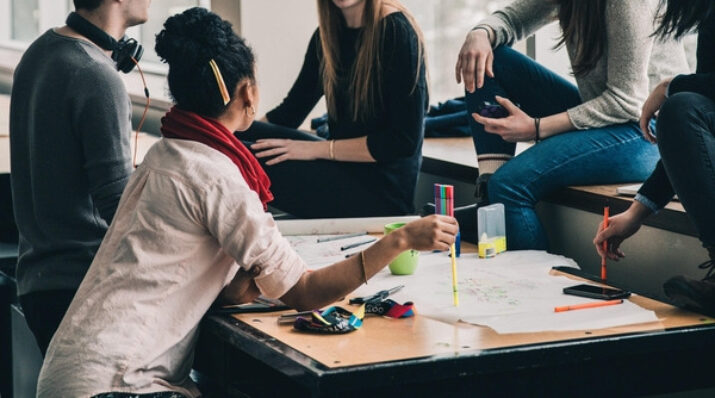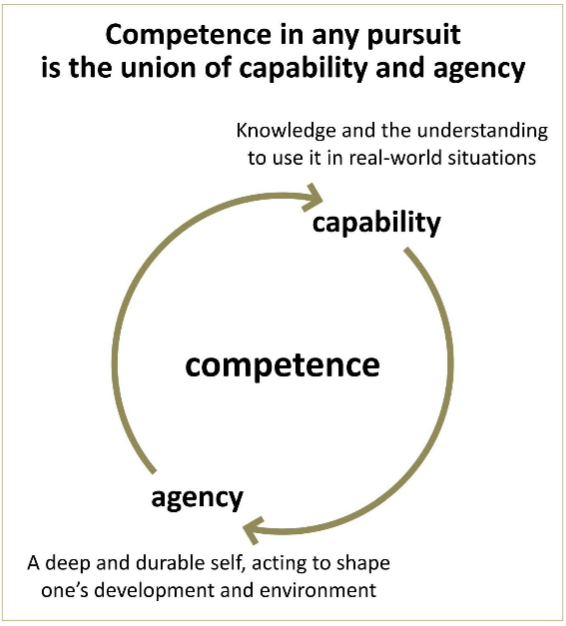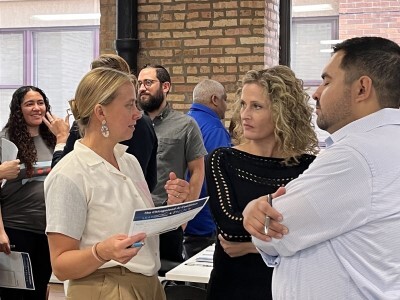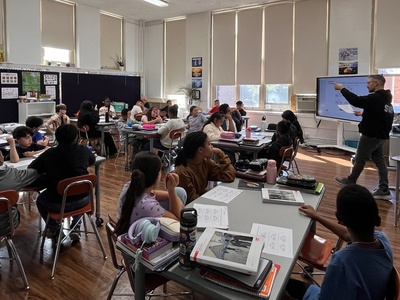Professional Learning
Innovation Equity
Topics

Educators are the lead learners in schools. If they are to enable powerful, authentic, deep learning among their students, they need to live that kind of learning and professional culture themselves. When everyone is part of that experiential through-line, that’s when next generation learning thrives.
People all over the country, and world, are working on the same education issues. We need to share out, listen, learn, and collaborate.
Two weeks ago a diverse group of Boston Public Schools (BPS) educators and administrators, both school- and central-office-based, went to the hubble and bubble that is the iNACOL symposium. Some went as presenters and others as attendees, but all went as learner-representatives networking our local conversations around innovation and personalized learning with those happening in other localities and the nation at large.
All too often innovation conversations stay siloed, whether locally within a particular professional learning community or school or district—or, conversely, within the national learning community of researchers, foundation officials, non-profit teams, innovative school networks, and state, district, charter management organization, and school administrators who participate in the conference merry-go-round. As with so much in our nation these days, we are often in our own echo-chambers; the local and national conversations don’t connect as much as they truly need to.
Breaking down these silos is vital if we want our work to take deep root, grow, and spread. As one BPS school-based attendee wrote after the conference, “Possibly my most powerful takeaway is that people all over the country, and world, are working on the same education issues that I am trying to address right here in Boston. To address them efficiently and effectively, we need to share out, listen, learn, and collaborate. We need to work together to push one another's thinking.”
At the Boston Public Schools Office of Innovation we are consciously making an effort to break down these silos. We define our strategy as growing innovation equity. Innovation, for us, is a broad, process-based term that includes the movement toward next generation learning that prepares students for the radically changing world of work and life, as well as prepares them and the system’s adults to embrace a culture of change that generates new solutions to problems.
We envision equity in both of its common senses: in its social justice sense of eliminating system bias to provide fair, authentic opportunities for all, and in its investment sense of creating ownership stakes in the endeavor of designing and living a next gen educational system for all our learners.
To accomplish this we ask ourselves:
- How can we equitably grow innovation competence?
- How can we equitably grow innovation opportunities?
- How can we equitably grow innovation networks?
We believe that the more we succeed in responding to these questions, the more innovation equity we are growing our system.
Personalized learning that prepares each of our learners for college, career, and life is one of our innovation ambitions. It is, as we see it, an innovation equity issue, and toward that end, we want to offer our educators and administrators the opportunity to experience personalized learning. Conferences--as places where growing innovation competence and innovation networks enable new innovation opportunities--are one key part of our innovation equity strategy.
Conferences as Authentic Personalized Learning
Most professional development is one-size-fits-all. It may be about personalized learning, but rarely does it live personalized learning. By personalized learning we mean meeting the distinct learning needs, interests, and aspirations of individual learners in a way that gives them voice and choice in what, how, when, and where they learn, thereby growing their competence, expertise, and connectedness to action in the world.
Conferences, especially ones as large as iNACOL, often exemplify personalized learning in action. Given that there were 200+ sessions offered by real-world experts, every single member of the BPS team had enormous opportunities for choice, voice, and authenticity in designing their learning trajectories. They could tailor their conference experience to meet their needs and goals, and connect with others in the process.
When we debriefed in our virtual Workplace group after the conference, we learned that, even without prior coordination, different people had, based on their roles, gravitated towards different specializations. These included microcredentials, piloting processes, sustaining innovation, specific learning tools, specific planning tools, student agency, design thinking, assessment, and ecosystem development.
As one central office-based attendee wrote:
I intentionally attended sessions that focused on the process of piloting, sustaining, and expanding an initiative, instructional focus, or program largely because of my role as part of the Excellence for All team which is developing equity programs in 13 of our elementary schools...I wanted to hear from experts about how they navigated the challenges (logistical, political, and creative), and how they came to realize best practices. Sessions like “Sustaining a Breakthrough Model” and “Lessons from the Last 5 Years of Implementation” were great for this purpose. I also sat in on sessions that focused on student agency.
Overall, I came away inspired to try to take more bold risks. I realize that as a new employee, I’m taking time to learn a lot about BPS as a whole; at times, I’ve hesitated to make decisions in fear of doing “the wrong thing.” But the iNACOL conference sessions I attended encouraged me to embrace the fact that with innovation comes both mistakes and rewards.
The reflection above clearly demonstrates growing innovation competence, as competence is defined by the MyWays framework shown below:

Given the opportunity to exercise agency in an authentic, real world situation, our adult learners had naturally gone about growing their innovation competence—and thereby their innovation equity (ownership).
They also had invaluable opportunities to expand their innovation networks, which will, as they continue their work at BPS, enable greater innovation opportunities throughout the district. Large urban districts like Boston are generally not directly affiliated with the six types of formalized innovation networks described by Tom Vander Ark, but the development of very loose informal networks across which ideas, tools, frameworks, and processes can flow is crucial for next gen learning to cross the innovation adoption chasm. As a school-based attendee wrote:
The session titled "Clarity, Credibility and Capacity in Personalizing Learning: A First Look at the Tool Lindsay Unified School District, Summit Learning and Transcend Education Are Creating Together" gave me two concrete tools I've already shared with my admin team. The "Instructional Look Fors Framework" creates language and clarity around the buzzword "personalized learning." The "Site Level Playbook" articulates what conditions district and school leaders need to create before teachers can create meaningful personalized learning experiences. I’ve also shared the Building 21 competency framework with our Instructional Leadership Team and I have at least two teachers who are deeply diving into their respective subjects.
Yet another BPS central office administrator explained that her ‘a-ha’ moment with regards to personalized learning came from the ability to network and learn from other districts:
I have been trying to clarify for myself what it means to DO personalized learning beyond some of the simplistic blended learning models I've see in schools. Learning the paths other districts have taken, their challenges, and successes helped clarify what this thing really is. It's more than just technology. It's a complete mindset shift that makes the student the star of the show--but not just the old idea of an average student. Personalized Learning is the ultimate Universal Design for Learning model (at least to me) because it says "each child is different but each child is able to learn. so let's create a whole system in which we shift the curricular, assessment, and instructional structures to be responsive to children.
That, after all, is our theory of action: create innovation equity for adults so that they take ownership of creating innovation equity for students.
Over time we fully expect these innovative BPS schools and departments to be sending their own innovation tools, frameworks, and models into the informal networks they are developing.
Innovation Equity Outcomes
Our attendees left iNACOL having grown innovation equity in three major areas: knowledge, agency (ownership), and networks. They also came to understand the social justice urgency of personalized learning. As one attendee eloquently shared after the conference, “Personalized learning is an equity issue. By providing a personalized learning schooling experience to each child that pushes every child towards mastery using the intersection of student-centered approaches and blended learning, we are essentially removing barriers to achievement.”
What remains then, is for them to create the opportunities to use this newly gained innovation capital in real world situations in the context of their own roles. This work will move our learning system towards a next gen model—one that, we hope, can increasingly open these sorts of authentic, personalized opportunities for our students. That, after all, is our theory of action: create innovation equity for adults so that they take ownership of creating innovation equity for students. As one of our attendees wrote, “The repeated message over and over again at each session was that it is impossible to have too much student voice in learning. All schools everywhere need to continue to work on bringing student voice to big decisions.” This, in the end, is the ultimate innovation goal.




